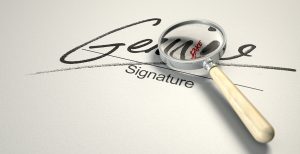What Is Automated Signature Verification?

You may already know that automated signature verification is a tool that automatically verifies signatures to protect against forgery and fraud. But, do you know how this process works or why it’s beneficial to you and your clients? Here’s a closer look.
How Does Automated Signature Verification Work?
The exact nuts and bolts of this type of software is difficult to understand, but essentially, these programs rely on pattern recognition, geometrical analysis, and other analytical tools to verify signatures on checks or other documents.
With automated signature verification tools, the software first identifies signature(s) on the check or document. . Then, it automatically compares that signature with a signature on file. If the program can’t conclusively verify the signature, it cleans up the area and checks the signature again. This is a relatively recent development in the world of signature verification—in the past, unclear signatures had to be manually verified. At that point, if the software still can’t verify the signature, it flags the document for manual review.
What Threats Does Automated Signature Verification Protect Against?
The main purposes of automated signature verification is to protect both your bank and your customers from fraudulent checks. Many banks automatically process checks under a certain value, putting them at risk of accepting forged checks. Then, they manually perform spot checks and look at checks over certain values, a process which ultimately wastes both time and money.
Automated signature verification gives you an affordable and virtually effortless way to verify the signatures on all checks, regardless of their face value. At the same time, these tools also help to reduce the number of checks that need manual verification. The automated signature verification process can be applied to any type of document not just checks.
Can You Set Parameters of Automated Check Verification?
That said, even with the best system, you don’t necessarily want to rely on automated solutions to check every single signature. Luckily, most systems allow you to set parameters, so that transactions meeting certain criteria can be identified for manual review.
For instance, depending on the automated signature tools that you use, you can set parameters related to the amount of the transaction, the volume of transactions from a certain account, or other elements.
What Automated Signature Verification Tools Are the Best?
There are a few different automatic signature verification tools on the marketplace, and to ensure you’re getting the best product for your needs, you should look for the following elements:
- Template flexibility that works with multiple check designs and layouts
- Able to handle multiple signatures, which is particularly important for commercial or joint accounts that require two signatures for every transaction
- Ability to decipher between the signature and other written text in that area
- Continuous learning capabilities for faster verifications over time
- Compatibility with multiple types of payments such as Automated Clearing House (ACH), Direct Debit Systems (DDS), etc.
Are There Other Types of Signature Verification?
In addition to automated signature verification, there is also electronic and visual signature verification. Electronic signature programs let you capture signatures from passports or photo IDs, and these programs also let you take signatures from your clients at your branch. Then, you can use these signatures to verify any documents that get presented to your bank.
Visual signature verification tools display signatures you have captured from your clients on the screen next to the check or document you are verifying. That streamlines the process and gives your employees all the details they need to effectively verify signatures.
At SQN Banking Systems, we offer Sentry: SigCheck to clients who are looking for automated signature verification solutions, and we also have a variety of other tools to facilitate everything from e-signing to fraud protection. Contact us today online or over the phone at 1-888-744-7226. We can help bring your transaction security into the 21st century.
